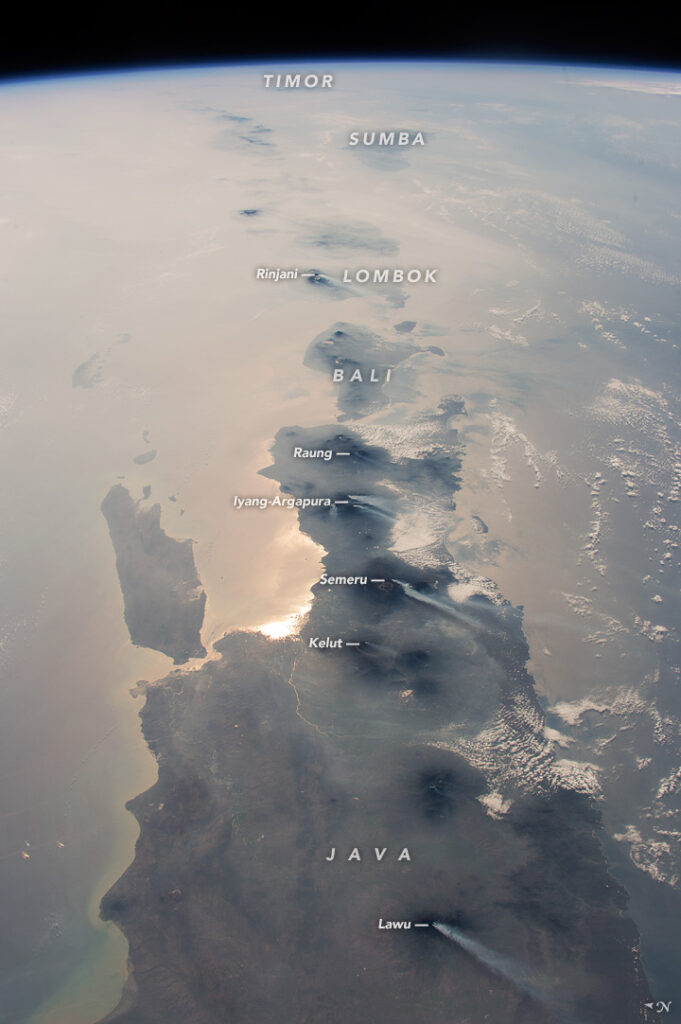Indonesia is often obscured by cloud cover but an astronaut aboard the International Space Station seized the opportunity of a storm-free day to photograph half the length of Indonesia’s main island chain.
It’s not only incredible because of the view but also because the image managed to capture.

7 simultaneous volcanic eruptions.
6 of which are happening on the island of Java – the most populated island in the world.
As a somewhat pale European, I clearly remember seeing my first Volcanic Eruption.
It was fascinating.
And yet nothing incredible. From where I was standing it looked like not much more than a very big smoking chimney.
WATCH THE VIDEO
And yet it was much more than that.
Following a number of earthquakes and seismic activity on 30th of September 2017
122,500 people were evacuated from their homes surrounding the Agung volcano in Bali.
The Indonesian National Disaster Management Authority declared a 12-kilometer exclusion zone
As the eruption intensified over the next week two of the local airports were temporarily shut down.
The silly traveler in me said this was great – Stuck on an island during a volcanic Eruption – what more could you want from a holiday?
Unsurprisingly my mother didn’t agree. Leave now she said.
As a good mother, she was overestimating the danger.
The only casualty was Bali’s tourist industry which apparently suffered a brief 30% decline.
My mother just like most westerners would never under any circumstance live next to an active volcano.
Who in their right mind would do that?
The Republic of Indonesia
is a country in Southeast Asia between the Indian and Pacific oceans.
It consists of over 17,000 islands
And it is the world’s largest archipelagic state and the 14th-largest country by area, at 1,904,569 square kilometers. Making it a tiny bit smaller than Mexico.
And With over 275 million people, Indonesia is the world’s fourth-most populous country.
It contains the island of Java the home to more than half of the country’s population.
Indonesia has the most volcanoes of any country in the world
At least 130 of them are active as a result Volcanoes are one of the most prevalent natural disasters in the country.
The most active of Volcanoes are Kelut and Mount Merapi both of which are located on the island of Java.
Over 350 thousand people live within 10 kilometers of Kelud
And Merapi is located in one of the most densely populated parts of Java with over 11,000 people living just on its slopes.
The perilous future of living next to these giants does not trouble the locals one bit because they know their history.
Indeed Indonesians are used to calamity.
For almost 60 years, since independence, Indonesia has lurched from one disaster to another, never quite recovering before the next one hits:
Earthquakes, floods, and volcanic eruptions for the most part, and a good deal of human-induced upheaval as well, in the shape of revolution, rebellion and retribution.
They have become stoic to a fault, but also jaded and despondent as there isn’t much that they can do about it.
In 1815, the giant eruption of Mount Tambora, a stratovolcano had such a large effect on the climate that the following year, in Europe was known as the year without summer.
Some 40 km cubed of ash were produced as a result of the eruption
An Estimated 90,000 people were killed as a result of about 10,000 directly from the eruption and about 80,000 from crop loss and famine.
And in 1883 you had the catastrophic eruption of Krakatoa, a volcanic island in Lampung, the resulting tsunamis killed about 36,000 people, and approximately two-thirds of the original island was destroyed.
And this is the incredible Lake Toba.
Its about 100 kilometers (62 miles) long, 30 kilometers (19 mi) wide, and up to 505 meters (1,657 ft) deep. It is the largest lake in Indonesia and the largest volcanic lake in the world.
It is the site of a supervolcanic eruption that occurred some 69,000 to 77,000 years ago
The Largest-known explosive eruption on Earth in the last 25 million years.
It has been accepted that the eruption led to a volcanic winter with a worldwide decrease in temperature between 3 to 5 °C (5.4 to 9.0 °F), and up to 15 °C (27 °F) in higher latitudes.
And Additional studies in Lake Malawi in East Africa have shown significant amounts of ash being deposited from the Toba Caldera eruptions
That is a distance of over 7 thousand 2 hundred kilometers.
Yet knowing the dangers people choose to live so close and have remarkably little fear.
The USA with a total of about 169 active volcanoes has only a few thousand people actually live near. In part because most of them are situated in Alaska.
By comparison in Indonesia, it is estimated that as many as 10 million people live next to active volcanoes.
The hard truth is that most often people stay because they have little or no choice.
For agricultural communities developing on Volcanic land can be very rewarding.
Most people who live in these zones are very aware of the dangers but to earn a living they must stay put.
And this doesn’t go just for Volcanoes but for areas prone to tsunamis and flooding.
Coasts and river flood plains are good for fishing and farming while valley and volcanic soils are fertile.
But there is also a cultural and religious aspect that helps the population accept their predicament.
People living close to volcanoes usually have rituals to worship their volcanic masters.
Most of Indonesia’s volcanoes have spiritual significance to one group of people or another.
Nearly everyone has a myth and supernatural being associated with it. Many are honored with festivals and offerings by local people.
Being Muslim has not stopped the Javanese from practicing volcano worship.
In some areas, people are openly willing to sacrifice safety in return for a volcanic reward.
Old beliefs like
The volcano gives you everything and the volcano takes it back
This sort of reasoning gives the people additional fortitude to face danger and simply accept risks rather than run.
Volcanoes stand at the heart of a complicated set of mystical beliefs that grip millions of Indonesians
Their peaks attract holy men and pilgrims.
Their eruptions are meant to predict political change and social upheaval.
You might say that in Indonesia, volcanoes are a cultural cauldron in which mysticism, modern life, Islam, and other religions mix.
In Java, there is a ritual known as Yadnya Kasada of the Tenggerese people – an ethnic subgroup of the Javanese.
The ritual serves as a way of expressing appreciation to their gods, whom they believe have granted them with blessings, abundance, and welfare.
The Tenggerese live in some sixty villages surrounding the Tengger mountains including the ever active Mount Bromo
The origin of this festival is a legend that dates back to the fall of the Majapahit kingdom.
Then the princess of the kingdom and her husband Roro Anteng took refuge in the upper slopes of Mount Bromo.
The couple and their followers later settled in the Tengger mountains and ruled the region
Under their leadership, Tenngerese people settled and began to flourish, but the couple was not happy as they remained childless after many years of marriage.
Therefore, they meditated atop Mount Bromo, beseeching the mountain gods for assistance.
The gods granted them 24 children on the condition that the 25th child must be thrown into the volcano as human sacrifice.
Bargain…. I guess?
The gods’ request was observed, and so the tradition of offering sacrifices thrown into the volcano to appease the deities continues until today, but, of course, with no sacrifices of humans.
chickens, goats and vegetables are accepted as well as cash.
Often locals clamber down into the crater, to retrieve the sacrificed goods in daring rescue attempts trying to stop the items from falling into the crater.
This is in fact encouraged as its meant to bring good luck.
Unsurprisingly Yadnya Kasada brings in thousands of tourists each July who come for the spectacle and the national park around it is one of the most visited attractions in Java.
So given the overal prevalence and acceptance of life near volcanoes. They do not seem to be a significant factor when it comes to peoples choices about where they live at all.
A 2014 study from Princeton University looked at migration between provinces in Indonesia.
They found temperature and precipitation to be important factors that promoted migration.
Natural disasters on the other hand such as tsunamis volcanoes and earthquakes were not statistically significant.
And the people who had been relocated due to natural disasters almost always came back as soon as the calamities were over.
The data was collected by following some 7000 thousand families where the researchers would call them every few years and ask about where and why they moved.
Still as often is the case people need help when calamities do arise.
And understandign just how unwilling people are to abandon their homes because its their livelihood is important.
Especially when they have families to feed.
Often during forced evacuations livestock owners will sneak back to their homes in order to feed their animals even duing eruptions.
For this reason the Indonesia government has incorporated evacuation plans for livestock
In Indonesia its simply impossible to move everyone away from danger and that is why robust evacuation plans such as these are needed in order to convince the most superstitious and follhardy to evacuate.
Volcanoes and various calamities also play a direct role in Politics
As it’s a given that human folly can trigger natural disasters.
Eruptions, earthquakes, even a toppling tree, have long been regarded as cosmic votes of no-confidence—a fact which the country’s former president, Susilo Bambang Yudhoyono, is painfully aware of.
Two months after the president’s inauguration in October 2004, an earthquake and tsunami struck Aceh Province on Sumatra, claiming 170,000 lives.
A quake hit Sumatra three months later, killing perhaps 1,000.
Then Mount Talang erupted, forcing thousands of villagers to flee their homes.
This then prompted a chain text message imploring Yudhoyono to perform a ritual to stop the calamities. “Mr. President,” it read, “please sacrifice 1,000 goats.”
Yudhoyono publicly refused saying “Even if I sacrificed a thousand goats,” he announced, “disasters in Indonesia will not end”
Many following calamities were attribute to the president.
In Indonesia it seems nature is still perceived as a living entity with the capacity and inclination to affect the lives of mortals.
And it chooses your destiny
I’m curious are you from Indonesia? Do you find that many of your peers or the older generations still hold such beliefs? Leave a comment
